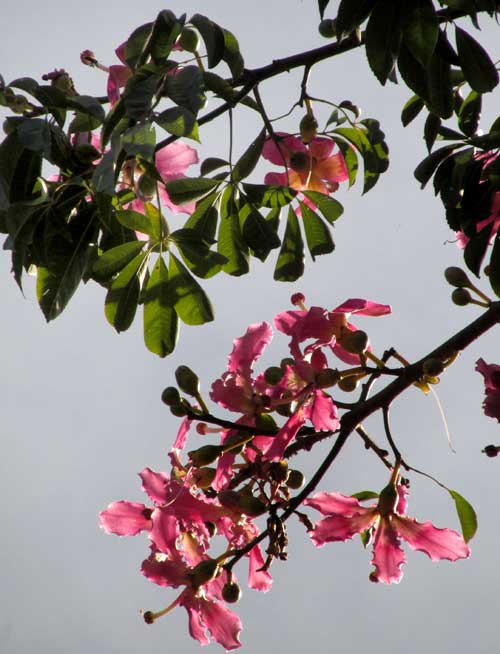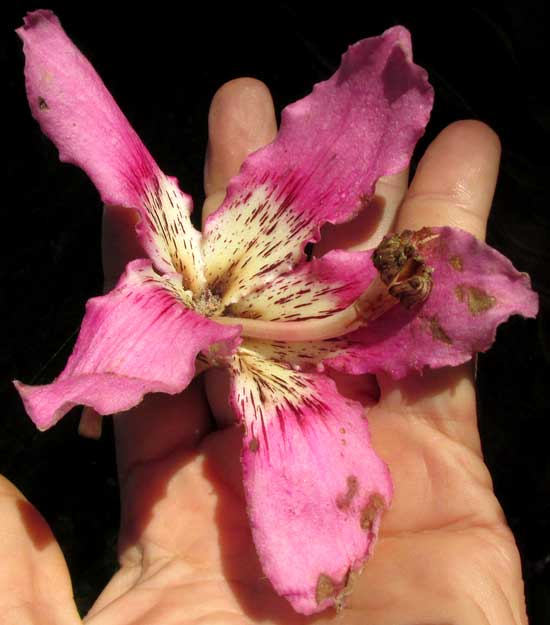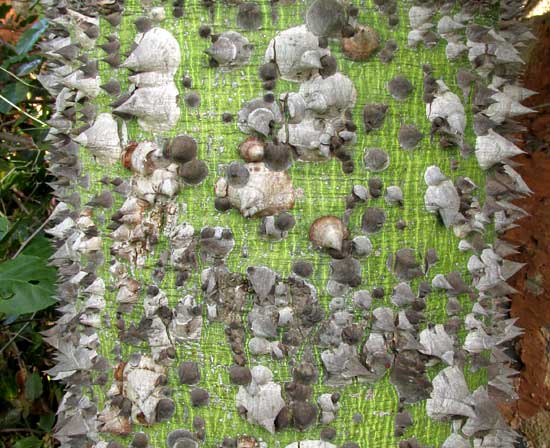Excerpts from Jim Conrad's
Naturalist Newsletter
from the October 29, 2017 Newsletter, a special on-the-road edition with notes taken in mid October near Tepotzlán, Morelos state, MÉXICO
Elevation about 5315 ft (1620m), at 18°59′07″N 99°05′59″W
A SOUTH AMERICAN CEIBA
That first morning when my Tepotzlán friend was showing me around his orchard, if someone in a balloon had soared high above us looking down, the landscape would have looked like a spinach pie with a bright cherry in it. The cherry would have been one of my friend's planted ornamental trees at its peak of flower production. You can see a branch of that gorgeous being below:

Notice that the tree's leaves are palmately, or digitately, compound -- consisting of several leaflets whose stalks, or petiolules, converge at the top of each leaf's petiole. Also notice that the stems are unusually thick, and that unopened flower buds are exceptionally large atop their own substantial stalks.
These are all features shared with our native, wild-growing Ceiba trees, Ceiba pentandra, famous for their potentially huge sizes, massive trunks, and their purported sacredness to the Maya. But this isn't Ceiba pentandra, as you can confirm on our Ceiba page at www.backyardnature.net/mexnat/ceiba.htm
On that page you can see that Ceiba pentandra also produces pinkish flowers, but they're much smaller than our Tepotzlán tree's flowers. A close-up of one of the Tepotzlán tree's fallen, slightly past-prime, large blossoms, with its stamens missing, is shown below:

So, from the beginning this Tepotzlán tree struck me as another Ceiba species, as as soon as I noticed its trunk, I knew that it had to be, as you can see below:

The sharp, woody, broad-based spines on smooth, green bark is very similar to what's seen on young trunks of our Mexican Ceibas, Ceiba pentandra.
Our Tepotzlán tree was CEIBA SPECIOSA, from South America, much planted as an ornamental tree throughout much of the world's warmer regions. Among its English names are False Kapok, Floss Silk Tree, Drunken Stick and Bottle Tree. All these names strike me as unworthy of such a dignified presence so I just think of it as the ornamental Ceiba from South America.
Once I'd realized what we had, I remembered first meeting the species in a park in Buenos Aires back in the mid 1970s, where people told me it was called Borracho, meaning "drunkard." That's because on mature trees the trunks swell to teardrop form, looking like the big stomachs of those who drink too much. The poor tree just gets no respect. The swollen trunks are water reservoirs, accounting for the species fame for being particularly drought tolerant.